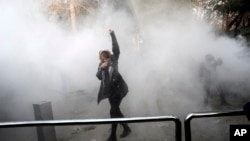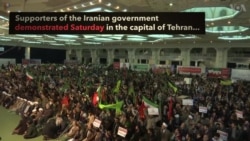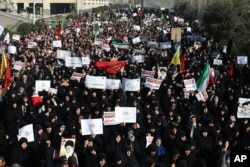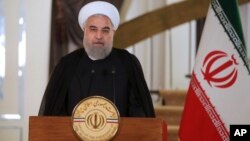Iran’s interior minister warned that those who “disrupt the order and break the law must be responsible for their behavior and pay the price,” after thousands of anti-government protesters marched for a third day on Saturday.
Abdolrahman Rahmani Fazli, in a statement on Iranian state television Sunday, said “fear and terror will definitely be confronted.”
At least two demonstrators were killed during clashes with police Saturday in the western town of Dorud.
VOA’s Persian service identified the victims as Hamzeh Lashni and Hossein Reshno after a reporter spoke to the victims’ families.
The semiofficial Mehr news agency Sunday quoted a regional government official confirming the two deaths.
WATCH: Amid Protests Across Iran, Trump Lashes Out at Tehran's Leaders
Video posted to social media purported to show the two victims following the shootings. Other online videos showed thousands of people protesting in several cities throughout Iran, including some attacking government buildings and violently confronting police.
There were reports that mobile devices were unable to access the internet for a period of time, but coverage was eventually restored, AFP reported.
Biggest protests since 2009
The uprisings, the biggest and most sustained since the 2009 presidential election protests, were sparked by high food prices. As many as 72 people died in the 2009 unrest after the regime cracked down on demonstrators challenging the re-election of then-President Mahmud Ahmadinejad.
Little information about the current protests is available, however, because state-run and semi-official news media have not widely reported on the demonstrations.
As a counter to the violence, separate state-sponsored rallies took place around the country to mark the end of the unrest that shook the country in 2009. State television reported pro-government rallies were held in about 1,200 cities and towns.
Cautions on social media use
Iran’s telecommunications minister Mohammad Javad Azari Jahromi sent a public message to the CEO of the messaging service Telegram, telling him, “A Telegram channel is encouraging hateful conduct: use of Molotov cocktails, armed uprising, and social unrest.” Telegram responded saying it had suspended the account.
Telegram CEO Pavel Durov also tweeted a public message, explaining why the account was suspended.
“A Telegram channel (amadnews) started to instruct their subscribers to use Molotov cocktail against police and got suspended due to our ‘no calls for violence’ rule. Be careful,” Durov said. “There are lines one shouldn’t cross.”
A prominent cleric, Ayatollah Mohsen Araki, told thousands of pro-government demonstrators in Tehran that “the enemy” wanted to use social media and economic issues to “foment a new sedition.”
Araki’s comments echoed an earlier statement by Senior Vice President Eshaq Jahangiri, who said Friday that some political factions were using the economy as an excuse to criticize the government.
State television broadcast images of the protests Saturday, something it rarely does, including acknowledging that some of the demonstrators were chanting the name of Iran’s last shah, who fled the country during the Islamic Revolution in 1979.
Anti-Rouhani rhetoric
The chants were seen as a cry against President Hassan Rouhani, who won re-election in May with promises to revive the economy.
Iran’s 2015 nuclear deal is seen as Rouhani’s major achievement. The deal, made with the United States and five other world powers, curbed Iran’s nuclear activities in exchange for relief from international sanctions. But economic growth has not followed, and people are struggling to cope with the high cost of living.
Some protesters have also been heard chanting slogans against Iran’s foreign policies, including its support for the regime of Syrian President Bashar al-Assad.
Social media postings, many of which were unverifiable, said protests took place Saturday in cities including Tehran, Shahr-e Kord, Kermanshah and Zanjan. Reports said that in some cities protesters set government buildings and police vehicles on fire.
Social media video purporting to be from the city of Mashhad seemed to show protesters overturning a police car and setting police motorcycles on fire.
The Mehr news agency posted videos purporting to show protesters attacking a town hall in central Tehran, overturning a police car, and burning the Iranian flag.
Amateur videos posted online appeared to show clashes at Tehran University, where police forces reportedly used tear gas to disperse protesters.
Protesters at the university chanted, “Seyed Ali [Khamenei] Shame On you. Leave The Country Alone,” according to a video sent to RFE/RL’s Radio Farda from the Iranian capital.
U.S. President Donald Trump denounced the Iranian government Saturday, tweeting excerpts from his September 19 speech to the U.N. General Assembly. He charged Rouhani’s government, and those before it, have long oppressed the Iranian people.
Three days of protests
Demonstrations were held in several cities and towns Thursday and Friday in protest against rising prices and the country’s high unemployment rate. Iran’s unemployment rate is 12.4 percent, its economy stagnant and inflation rampant.
In a statement Friday, the U.S. State Department said, “Iran’s leaders have turned a wealthy country with a rich history and culture into an economically depleted rogue state, whose chief exports are violence, bloodshed and chaos.”
The State Department urged “all nations to publicly support the Iranian people and their demands for basic rights and an end to corruption.”
RFE/RL contributed to this report.
















